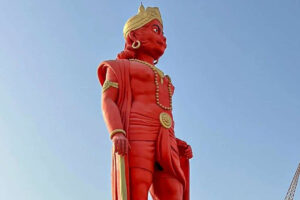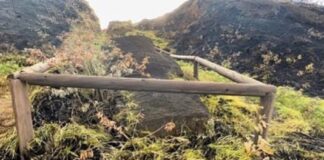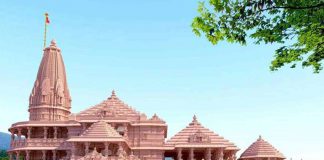APRIL 16, 2022

Was Lord Hanuman born in Karnataka or Andhra Pradesh? If we are to believe the stand taken by both states, the mighty god seems to be torn between them.
There has been a raging debate on Lord Hanuman’s real birthplace — Anjanadri hills near Tirumala hills in AP or the Anjaneya Betta in Karnataka’s Hampi. Amidst this, celebrations and special poojas to the deity were held in both locations for Hanuman Jayanthi on Saturday.
Karnataka has maintained that the Anjaneya Betta (mountain) located in the Koppal district is the real “Kishkindha”. Popular belief says that Ramayana’s Kishkindha, the kingdom of Vanara king Sugriva, was mapped to Anjanadri hills, near Hampi, and formed part of the Dandaka forest which extended from the Vindhyas down to the south.
The Tirumala Tirupati Devasthanams (TTD), a prestigious temple dedicated to Lord Venkateshwara, maintains that Hanuman was born in the Anjanadri hills in Tirumala, Andhra Pradesh. The TTD based its claim on the report of an eight-member committee headed by Professor Sannidhanam Sudarshana Sharma, vice chancellor of Sri Venkateswara Vedic University, in 2020.
Interestingly, three other states — Maharashtra (Anjaneri hills in Nashik), Gujarat (Anjan hill in Navsari), and Jharkhand (Anjan Dhamija near Gumla)— also claim that Hanuman was born in their region.
V Muralidhara Sharma, former vice chancellor of the National Sanskrit University and a member of the TTD committee, had conducted extensive research on Hanuman’s place of birth.
“My four months of extensive research based on puranic anthologies, literary and epigraphic evidence, and geographic details have indicated that Hanuman was born on Anjanadri hills in the Treta Yuga. Venkatachalam, the main deity at the Tirupati Devasthanam, is also known as Anjanadri and by 19 other names,” Sharma told the media in April 2021.
Amidst this standoff, Karnataka chief minister Basavaraj Bommai in his recent budget announced Rs 100 crore to develop the Anjanadri hills in Koppal, and work on the master plan to build a world-class pilgrimage centre there has already begun.
On February 17 this year, the TTD laid the foundation stone at Anjanadri hills in AP, but the work on the temple came to a grinding halt after the Andhra high court issued an order not to take up any kind of construction works, including the building of the temple.
A petition was filed in the HC by a group of devotees claiming that the consecration of an idol by human beings on the seven hills of Tirumala was against the Puranas. Consequently, the court issued an order to stop work on the temple.
However, work continues at the Anjanadri Betta in Karnataka. With the Ram temple on course in Ayodhya, a Hampi-based private trust, Hanumad Janmabhoomi Teertha Kshetra, has started initial work to build a 215-metre Hanuman statue, six metres short of the Ram statue in Ayodhya.
Govindananda Saraswathi Swami, the seer who heads the trust, told News18 that over the past two years, they have been collecting contributions from devotees to build the statue which is estimated to cost Rs 1,200 crore and will take six years to complete.
“Ram Bhaktha Hanuman is the eternal devotee of Lord Ram. While Lord Ram’s statue being built in Ayodhya is 221 metres tall, the highest in the world, Hanuman ji’s statue will be six metres shorter as he cannot be taller than his master,” Govindananda Saraswathi Swami said.
Speaking about the TTD’s claim that Hanuman was born in Tirumala, he said that the shrine has not been able to give solid evidence to prove the point.
“The court caught them red-handed after several fake documents were submitted in order to execute their (TTD’s) plan. They had plans to build a mega project without even cross-referencing whether the real Anjanadri hills (or the hill where Hanuman was born) was in Tirumala or in Hampi,” the seer told News18.
On the Hanuman project, he said that their plans as a trust were on track.
Devotees will have to walk 550 steps to reach the top of the hill where the temple and the idol will be located. With the state government funds of Rs 100 crore, the trust has drawn up plans to develop the entire area.
Dr Vasudev Badiger, professor of ancient history and archaeological studies at Kannada University, Hampi, says there are several inscriptions in the region which prove that Lord Hanuman was born in Anjanadri hills in Hampi.
Senior BJP leader and Chikkamagaluru MLA CT Ravi spoke to News 18 about Karnataka’s project.
“We want to make it part of the Ramayana circuit in India. There are three places in Karnataka itself that have a close connection with Ramayana. The Mahabaleshwar temple in Gokarna, Chandra Drona Parvatha range in Chikkamagaluru, and Anjaneya Betta near Hampi will be well placed and developed as part of the circuit.
Jagadguru Sri Ramabhadracharya of the Sri Tulasi Peeth Seva Nyas, Chitrakoot, sided with the TTD’s claim that Anjanadri hills in Tirumala was indeed Hanuman’s birthplace. Referring to the Vedas and Puranas, the seer said that several scriptures authenticate this statement.
However, Govindananda counters this argument, stating that the Tirupati Sthala Purana (Historical Stories of Tirupati) does mention Anjanadri, but the text was written after the Tirumala Devasthanam was developed. There is no reference otherwise, unlike in Valmiki’s Ramayana, he said, which mentions Hanuman’s birth in four different phases.
Courtesy/Source: News18








































































































